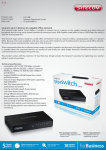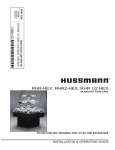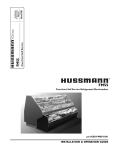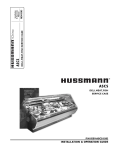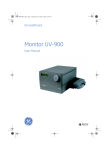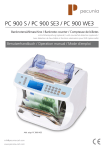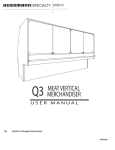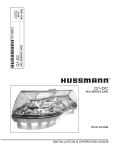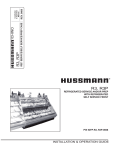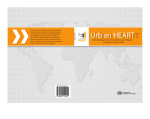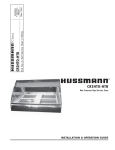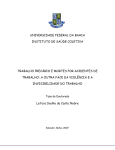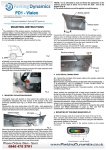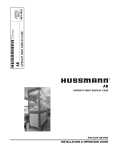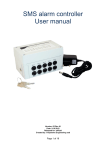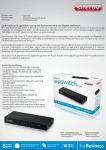Download hussman Saw VGM User's Manual
Transcript
REV. 0505 Vertical Glass Service Deli, Meat, Fish Case VGM, VGD /Chino Installation & Operation Manual Rev. 0505 VGM, VGD Vertical Glass Service Deli, Meat, Fish Case P/N VGM,VGD-0505 1 INSTALLATION & OPERATION GUIDE VGM, VGD-0505 General Instructions THIS BOOKLET CONTAINS INFORMATION ON: Contents General Instructions ................................................. 2 Important Information ............................................. 3 Cut & Plan Views ....................................................... 3 Installation ................................................................. 4 LOCATION ............................................................................................................. 4 UNCRATING THE STAND ....................................................................................... 4 LEVELING.............................................................................................................. 4 Plumbing .................................................................... 6 WASTE OUTLET AND P-TRAP .............................................................................. 6 INSTALLING CONDENSATE DRAIN ........................................................................ 6 Humidification .......................................................... 7 INSTRUCTIONS ...................................................................................................... 7 Refrigeration ............................................................. 8 REFRIGERANT TYPE ............................................................................................. 8 MEASURING THE OPERATING SUPERHEAT .......................................................... 8 T-STAT LOCATION .................................................................................................. 8 User Information ...................................................... 9 STOCKING .............................................................................................................. 9 IMPORTANT STEPS ................................................................................................ 9 CASE CLEANING .................................................................................................... 9 NON-GLARE GLASS ............................................................................................... 10 PLEXIGLASS & ACRYLIC CARE .............................................................................. 10 Maintenance .............................................................. 11 ELECTRICAL PRECAUTIONS ................................................................................... 11 REPLACING FLUORESCENT LAMPS ....................................................................... 11 TIPS & TROUBLESHOOTING ................................................................................. 11 LIFT UP GLASS ..................................................................................................... 11 Case Specifications ................................................... 14 Electrical Schematics ............................................... 15 Appendices ................................................................ 21 APPENDIX A. – Temperature Guidelines ............................................................ 21 APPENDIX B. – Application Recommendations .................................................. 21 APPENDIX C. – Field Recommendations ............................................................ 21 APPENDIX D. – Recommendations to user - .................................................... 22 Limited Warranty ..................................................... 23 VGM – Straight Glass Refrigerated Super High Volume Meat or Deli Case SHIPPING DAMAGE All equipment should be thoroughly examined for shipping damage before and during unloading. This equipment has been carefully inspected at our factory and the carrier has assumed responsibility for safe arrival. If damaged, either apparent or concealed, claim must be made to the carrier. APPARENT LOSS OR DAMAGE If there is an obvious loss or damage, it must be noted on the freight bill or express receipt and signed by the carrier’s agent; otherwise, carrier may refuse claim. The carrier will supply necessary claim forms. CONCEALED LOSS OR DAMAGE When loss or damage is not apparent until after equipment is un-crated, a claim for concealed damage is made. Make request in writing to carrier for inspection within 15 days, and retain all packaging. The carrier will supply inspection report and required claim forms. SHORTAGES Check your shipment for any possible shortages of material. If a shortage should exist and is found to be the responsibility of Hussmann Chino, notify Hussmann Chino. If such a shortage involves the carrier, notify the carrier immediately, and request an inspection. Hussmann Chino will acknowledge shortages within ten days from receipt of equipment. HUSSMANN CHINO PRODUCT CONTROL The serial number and shipping date of all equipment has been recorded in Hussmann’s files for warranty and replacement part purposes. All correspondence pertaining to warranty or parts ordering must include the serial number of each piece of equipment involved in order to provide the customer with the correct parts. Keep this booklet with the case at all times for future reference. /Chino A publication of Hussmann® Chino 13770 Ramona Avenue • Chino, California 91710 (909) 628-8942 FAX (909) 590-4910 (800) 395-9229 2 This equipment is to be installed to comply with the applicable NEC, Federal, State, and Local Plumbing and Construction Code having jurisdiction. Rev. 0505 Important Information The VGM / VGD service cases are easy to work, attractive merchandising display cases capable of maintaining superb product quality, with the installation of the proper controlling devices. These should be set according to Hussmann’s specifications and combined with a properly maintained humidity system. Incorrect settings and failure to maintain the humidity system will result in short product life from dehydration, shrinkage and discoloration. Below are a few guidelines to ensure optimum performance and product life. • • • • Cut & Plan Views 5 3/4" 5 1/2" 4 3/4" 26 1/2" 10" 28" T8 Front Deck Light 52 3/4" Optional Front Deck Light 52 3/4" 16" 1 /4" 1 /2 " 14" 29 35 28" 19 7/8" 32 3/4" 31" 4 1 /4 " 29 1/2" 45" 11 1/4" 12" 12" 21 3/16" Lift Up Deck For Easy Cleaning 21 3/16" 4 1/4" 29 1/2" 11 1/4" 45" VGD Straight Glass Service Deli Case VGM Scale = 1/4" Straight Glass Service Meat / Fish Case Scale = 1/2" 8" 8" CASE FRONT 1" 8'-2" (VARIABLE LENGTHS) VGD WATER, ELEC. & REFRIG. MECH. STUB UP AREA 19" X 19" DRAIN MECHANICAL STUB UP AREA 19" X 19" 45" 11" WATER, ELEC. & REFRIG. MECH. STUB UP AREA 19" X 19" DRAIN MECHANICAL STUB UP AREA 19" X 19" 45" • Review the Case Specification in this book to verify thermostat setting. Do not set temperature too cold, as this causes product dehydration. Temperatures should be achieved by a t-stat and suc- 11" • • tion solenoid at each case. Do not use EPR valves, liquid line solenoids or electronic control devices of any kind. These controls allow temperature swings causing product dehydration and excessive energy consumption. Defrost cycles should be set according to the Case Specifications in this book. Clean humidity system a minimum of every 90 days for proper system operation. Work and rotate product – not to exceed a four (4) hour period. Maintain sanitar y conditions throughout the deli holding, prep and working areas. Do not display product directly within the air discharge. CASE FRONT 1" 1" 8'-2" 1" (VARIABLE LENGTHS) VGM Plan View Plan View Scale = 1/4" Scale = 1/4" 3 VGM, VGD-0505 Installation LOCATION The refrigerated merchandisers have been designed for use only in air conditioned stores where temperature and humidity are maintained at or below 75°F and 55% relative humidity. DO NOT allow air conditioning, electric fans, ovens, open doors or windows (etc.) to create air currents around the merchandiser, as this will impair its correct operation. Product temperature should always be maintained at a constant and proper temperature. This means that from the time the product is received, through storage, preparation and display, the temperature of the product must be controlled to maximize life of the product. UNCRATING THE STAND Place the fixture as close to its permanent position as possible. Remove the top of the crate. Detach the walls from each other and remove from the skid. Unbolt the case from the skid. The fixture can now be lifted off the crate skid. Lift only at base of stand! EXTERIOR LOADING These models have not been structurally designed to support excessive external loading. Do not walk on their tops; This could cause serious personal injury and damage to the fixture. These steps should release any settled lubricant within the cylinders, and prevent any stress on the front glass. SETTING AND JOINING The sectional construction of these models enable them to be joined in line to give the effect of one continuous display. A joint trim kit is supplied with each joint. LEVELING IMPORTANT! IT IS IMPERATIVE THAT CASES BE LEVELED FROM FRONT TO BACK AND SIDE TO SIDE PRIOR TO JOINING. A LEVEL CASE IS NECESSARY TO INSURE PROPER OPERATION, WATER DRAINAGE, GLASS ALIGNMENT, AND OPERATION OF THE HINGES SUPPORTING THE GLASS. LEVELING THE CASE CORRECTLY WILL SOLVE MOST HINGE OPERATION PROBLEMS. NOTE: A. To avoid removing concrete flooring, begin lineup leveling from the highest point of the store floor. B. When wedges are involved in a lineup, set them first. All cases were leveled and joined prior to shipment to insure the closest possible fit when cases are joined in the field. When joining, use a carpenter’s level and shim legs accordingly. Case must be raised correctly, under legs where support is best, to prevent damage to case. 1. DANGER! IMPORTANT: READ BEFORE RAISING GLASS! HEX SCREWS ALONG CLAMSHELL MAY HAVE LOOSENED DURING SHIPPING!! RETIGHTEN ALL CLAMSHELL SCREWS BEFORE OPENING GLASS! RETIGHTEN GLASS AFTER CASE IS BROUGHT TO OPERATING TEMPERATURE FOR THE FIRST TIME! During shipment, the lubricant inside the cylinders may have settled. This settling may cause excessive or uneven tension on the glass—to the point of breakage. To avoid any damage, please follow these three easy steps: 1. Slowly raise and lower each glass section 6 times to a height of 6". 2. Increase the height to 12", and raise and lower the glass 6 more times. 3. Finally raise the glass to it’s full extension, and lower. 4 2. 3. 4. 5. Check level of floor where cases are to be set. Determine the highest point of the floor; cases will be set off this point. Set first case, and adjust legs over the highest part of the floor so that case is level. Prevent damage – case must be raised under leg or by use of 2x6 or 2x4 leg brace. Remove side and back leg braces after case is set. Set second case as close as possible to the first case, and level case to the first using the instructions in step one. Apply masking tape 1/8" in from end of case on inside and outside rear mullion on both cases to be joined. Apply liberal bead of case joint sealant (butyl) to dotted area shown in (Fig.2, #1) of first case. Apply heavy amount to cover entire shaded area. DO NOT USE PERMAGUM! It is the contractor's responsibility to install case(s) according to local construction and health codes. Rev. 0505 6. 7. 8. Slide second case up to first case snugly. Then level second case to the first case so glass front, bumper and top are flush. To compress silicone at joint, use two Jurgenson wood clamps. Make sure case is level from front to back and side to side on inside bulkheads at joint. Attach sections together via a 3 bolts located in the base of the case. Secure the overhead structure by bolting the rear mullions tegether. Do not use bolts to pull cases together! 9. Apply bead of silicone to top of bulkheads and slip on stainless steel bulkhead cap. Also apply silicone to seam between overhead light tubes. 10. VERY IMPORTANT! Apply liberal amounts of black silicone to area under interior lower legs and fill all voids down to bulkhead. 11. Use finger to smooth silicone as thin as possible at masking tape on inside and outside of rear mullion (apply additional silicone if necessary). Remove tape applied on line #3. BOLT SEALANT BOLT Figure 2 DO NOT SEAL JOINT TRIM TO FLOOR! 5 VGM, VGD-0505 Plumbing It is the contractor's responsibility to install case(s) according to local construction and health codes. WASTE OUTLET AND P-TRAP The waste outlet is located off the center of the case on one side allowing drip piping to be run lengthwise under the fixture. A 1-1/2" P-trap and threaded adapter are supplied with each fixture. The P-trap must be installed to prevent air leakage and insect entrance into the fixture. NOTE: PVC-DWV solvent cement is recommended. Follow the Hussmann’s instructions. 1. B DRAIN MECHANICAL STUB UP AREA 19" X 19" B CL DRAIN WATER, ELEC. & REFRIG. MECHANICAL STUB UP AREA 19" X 19" CASE FRONT CASE FRONT T-STAT AND BALLAST LOCATIONS 6 2. 3. 4. INSTALLING CONDENSATE DRAIN Poorly or improperly installed condensate drains can seriously interfere with the operation of this refrigerator, and result in costly maintenance and product losses. Please follow the recommendations listed below when installing condensate drains to insure a proper installation: T 1. 5. 6. Never use pipe for condensate drains smaller than the nominal diameter of the pipe or P-trap supplied with the case. When connecting condensate drains, the P-trap must be used as part of the condensate drain to prevent air leakage or insect entrance. Store plumbing system floor drains should be at least 14" off the center of the case to allow use of the P-trap pipe section. Never use two water seals in series in any one line. Double P-traps in series will cause a lock and prevent draining. Always provide as much down hill slope (“fall”) as possible; 1/8" per foot is the preferred minimum. PVC pipe, when used, must be supported to maintain the 1/8" pitch and to prevent warping. Avoid long runs of condensate drains. Long runs make it impossible to provide the “fall” necessary for good drainage. Provide a suitable air break between the flood rim of the floor drain and outlet of condensate drain. 1" is ideal. Prevent condensate drains from freezing: a. Do not install condensate drains in contact with non-insulated suction lines. Suction lines should be insulated with a nonabsorbent insulation material such as Armstrong’s Armaflex. b. Where condensate drains are located in dead air spaces (between refrigerators or between a refrigerator and a wall), provide means to prevent freezing. The water seal should be insulated to prevent condensation. Rev. 0505 Humidification connecting “L”, remove it from the case, and HUMIDIFICATION SYSTEM (WHERE APPLICABLE) flushing with a hose. One contributor to spoilage of fresh meat and deli products that are displayed in refrigerated service type merchandisers is dehydration, which causes the product to shrink and dry out. The humidification system is designed to maintain a high relative humidity (RH) inside Hussmann’s refrigerated service type merchandisers— and minimize dehydration. The humidification system is located on the back wall under the rear discharge air grill of the VGM / VGD FAMILY. It is imperative that the system be maintained as per the instructions in the maintenance section. Buildup of residue will cause leakage and/or unfavorable water conditions. If the area’s water is hard, check the system more frequently than under good water conditions. IMPORTANT INFORMATION INSTRUCTIONS Turn on water and fans, and check for leaks. This system has been tested at the factory, and should not require any additional adjustments. The system is constructed almost entirely of PVC pipe, and user air that is sub-cooled to approximately the same temperature as the case. The sub-cooling of air inhibits the formation of growth found to be a problem in other humidification systems. Maintenance is almost unnecessary if you follow a few simple rules: 1. Keep the case clean. 2. Keep the water filter clean, and change it every 612 months, depending on the kind of water found in your area. 3. Flush the header every 6 months, by loosening the The VGM / VGD case line is easy to work, and capable of maintaining superb product quality with the installation of the proper controlling devices. These should be set according to the Hussmann’s specifications, and a properly maintained humidity system. Incorrect settings and failure to maintain the humidity system will result in short product life. Below are a few guidelines for optimum performance and product life: • Set thermostat to cut in at 30º-32ºF discharge temperature, to maintain a temperature for Deli, Meat, and Fish at 36ºF. DO NOT set temperature too cold, as this causes product dehydration. • Temperatures should be achieved by means of a T-Stat and Suction Solenoid at each case. DO NOT use EPR valves. Liquid Line Solenoids, or electronic control devices of any kind. These controls allow temperature swings that cause dehydration and excessive energy consumption. • Clean humidity system a minimum of every 90 days for proper system operation. • Work and rotate product - not to exceed a 4-hour period. • At night, turn off case lights, and cover product with moistened cheese cloth or fabric towels. • Keep meat prep room refrigerated at 55ºF. • Meat Bloom Box (if applicable ) should be at 30ºF. HUMIDITY SYSTEM as viewed from the front. NOTE: The axial fans included in the humidity system must be replaced as a unit. Humidity Out-Put - 1/2 gallon per hour per nozzle. One (1) nozzle in all VGMs. 1/8" 100 X 1/8FPT SW ADAPTER 225-01-3220 1/4" 100 X 1/8FPT SPRAY HEADER HAGO-M1 NOZZLE SW ADAPTER RUNS LENGTH OF CASE 225-01-3221 225-01-2089A REAR INTERIOR WALL OF CASE VIEWED FROM FRONT 1/4"MPT X 1/4" COMP PVC ADAPTER 225-01-2026 1/4" OD X 1/8" FPT SW ADAPTER 225-01-3059 1/8" MPT X 1/4" COMP PVC ADAPTER 225-01-3059 PAN AND ACCESS PANEL WATER SUPPLY 1/4"MPT X 1/4" OD BALL VALVE WATER FILTER COMP ADAPTER HAMMON 3 STAGE #00015 225-01-1312 225-01-2026 225-01-2026 2ND FAN USED IN 12' CASE 3" AXIAL FAN 225-01-2026 7 VGM, VGD-0505 Refrigeration THERMOSTATIC EXPANSION VALVE LOCATION REFRIGERANT TYPE The standard refrigerant will be R-22 unless otherwise specified on the customer order. Check the serial plate on the case for information. REFRIGERATION LINES LIQUID SUCTION 3/8" O.D. 5/8" O.D. NOTE: The standard coil is piped at 5/8" (suction); however, the store tie-in may vary depending on the number of coils and the draw the case has. Depending on the case setup, the connecting point in the store may be 5 /8", 7/8", or 11/8". Refer to the particular case you are hooking up. Refrigerant lines should be sized as shown on the refrigeration legend furnished by the store. Install P-traps (oil traps) at the base of all suction line vertical risers. Pressure drop can rob the system of capacity. To keep the pressure drop to a minimum, keep refrigerant line run as short as possible, using the minimum number of elbows. Where elbows are required, use long radius elbows only. CONTROL SETTINGS See the “Case Specs” section of this guidebook for the appropriate settings for your merchandiser. Maintain these parameters to achieve near constant product temperatures. Product temperature should be measured first thing in the morning, after having been refrigerated overnight. For all multiplexing, defrost should be time terminated. Defrost times should as directed in the Case Specifications section of this guide. The number of defrosts per day should never change. The duration of the defrost cycle may be adjusted to meet conditions present at your location. This device is located on the same side as the refrigeration stub. An ALCO expansion valve model is furnished as standard equipment, unless otherwise specified by customer. EXPANSION VALVE ADJUSTMENT There is one (1) valve on the right side of each coil. MEASURING THE OPERATING SUPERHEAT 1. Determine the suction pressure with an accurate pressure gauge at the evaporator outlet. 2. From a refrigerant pressure temperature chart, determine the saturation temperature at the observed suction pressure. 3. Measure the temperature of the suction gas at the thermostatic remote bulb location. 4. Subtract the saturation temperature obtained in step No. 2 from the temperature measured in step No. 3. 5. The difference is superheat. 6. Set the superheat for 5°F - 7°F. T-STAT LOCATION T-Stats are located within the electrical raceway. Refer to diagram below. T B DRAIN MECHANICAL STUB UP AREA 19" X 19" B CL DRAIN WATER, ELEC. & REFRIG. MECHANICAL STUB UP AREA 19" X 19" CASE FRONT CASE FRONT T-STAT AND BALLAST LOCATIONS ACCESS TO TX VALVES & DRAIN LINES SELF CONTAINED CASES MECHANICAL - Remove product from end of case. Remove product racks. Remove refrigeration and drain access panels (labeled). TX valve (mechanical only) and drain are located under each access panel at end of the case. ELECTRONIC - The Electronic Expansion valve master and slave cylinder(s) are located within the electrical access panel(s). The only difference between a remote case and a selfcontained case is the addition of a condensing unit. ELECTRONIC EXPANSION VALVE (OPTIONAL) A wide variety of electronic expansion valves and case controllers can be utilized. Please refer to EEV and controller Hussmanns information sheet. Sensors for electronic expansion valves will be installed on the coil inlet, coil outlet, and in the discharge air. (Some supermarkets require a 4th sensor in the return air). Case controllers will be located in the electrical raceway or under the case 8 SELF CONTAINED START-UP Self contained cases are totally ready to run once power is supplied. All controls are set and units charged with refrigerant. DEFROST SET-UP Defrost times vary according to case model - refer to Case specification section in the back of the book for proper duration and frequency. Self contained cases have individual defrost time clocks. When power has been applied, set the time clock to the proper duration and frequency. The time clock is located behind the front panel under the case. Turn the clock dial counterclockwise until the pointer is directed to the current time of day. Rev. 0505 User Information STOCKING Improper temperature and lighting will cause serious product loss. Discoloration, dehydration and spoilage can be controlled with proper use of the equipment and handling of product. Product temperature should always be maintained at a constant and proper temperature. This means that from the time the product is received, through storage, preparation and display, the temperature of the product must be controlled to maximize life of the product. Hussmann cases were not designed to “heat up” or “cool down” product—but rather to maintain an item’s proper temperature for maximum shelf life. To achieve the protection required always: 1. Minimize processing time to avoid damaging temperature rise to the product. Product should be at proper temperature. 2. Keep the air in and around the case area free of foreign gasses and fumes or food will rapidly deteriorate. 3. Maintain the display merchandisers temperature controls as outlined in the refrigerator section of this manual. 4. Do not place any product into these refrigerators until all controls have been adjusted and they are operating at the proper temperature. Allow merchandiser to operate a minimum of 6 hours before stocking with any product. 5. When stocking, never allow the product to extend beyond the recommended load limit. Air discharge and return air flue must be unobstructed at all times to provide proper refrigeration. 6. There are vents located at the base of the front of the glass, just above the front rail. These vents supply a continuous, gentle flow of air across the front glass which inhibits condensation. Do not place any signs or other restrictive objects on the front of the refrigerator that will block these vents. 7. Keep the service doors closed (when applicable). Refrigeration performance will be seriously affected if left open for a prolonged period of time. 8. Avoid the use of supplemental flood or spot lighting. Display light intensity has been designed for maximum visibility and product life at the factory.The use of higher output fluorescent lamps (H.O. and V.H.O.), will shorten the shelf life of the product. 9. In the Deli cases, completely cover the product each night with a clean damp cloth or butcher paper (never use plastic, as it does not allow appearance and significantly shortening product shelf life. 10. Cold coils remove heat and moisture from the case and deposit this as frost onto the coil. Thus, a defrost is required. Our humidity system induces moisture into the case and helps slow down the dehydration process. The only other moisture within the case is that in the product itself. A single level of meat will dry out faster than a fully loaded case of 3–4 levels of meat. IMPORTANT STEPS 1. For temperature settings, please see the Case Specifications section in this book. 2. Temperature control should be by means of a T-Stat and Suction Stop Solenoid at each case. Do not use EPR valves, Liquid Line Solenoids or electronic control devices of any kind, as these allow temperature swings causing dehydration and excessive energy consumption. 3. Product should be worked and rotated on a regular basis, not to exceed a 4-hour period. 4. At night, turn off case lights and cover the product with a damp (not wet) cloth similar to cheese cloth (etc.). This should be washed out in the morning and kept in a walk-in box during the day—so that it is cool and moist when covering the product. 5. Discharge air temperature should be approximately 26°F, with between 150-200 FPM air velocity. Do not display product directly within the air discharge. 6. Clean Humidity system a minimum of every 90 days for proper system operation. CASE CLEANING Long life and satisfactory performance of any equipment are dependent upon the care given to it. To insure long life, proper sanitation and minimum maintenance costs, the refrigerator should be thoroughly cleaned frequently. SHUT OFF FAN DURING CLEANING PROCESS. It can be unplugged within the case, or shut off case at the source. The interior bottom may be cleaned with any domestic soap or detergent based cleaners. Sanitizing solutions will not harm the interior bottom, however, these solutions should always be used according to the Hussmann’s directions. It is essential to establish and regulate cleaning procedures. This will minimize bacteria causing discoloration which leads to degraded product Soap and hot water are not enough to kill this bacteria. A sanitizing solution must be included with each cleaning process to eliminate this bacteria. 1. Scrub thoroughly, cleaning all surfaces, with soap and 9 VGM, VGD-0505 2. 3. 4. 5. hot water. Rinse with hot water, but do not flood. Apply the sanitizing solution according to Hussmann’s directions. Rinse thoroughly. Dry completely before resuming operation. PLEXIGLASS & ACRYLIC CARE Improper cleaning not only accelerates the cleaning cycle but also degrades the quality of this surface. Normal daily buffing motions can generated static cling attracting dust to the surface. Incorrect cleaning agents or cleaning cloths can cause micro scratching of the surface, causing the plastic to haze over time. CLEANING GLASS & MIRRORS CLEANING Only use a soft cloth and mild glass cleaner for cleaning any glass or mirrored components. Be sure to rinse and/ or dry completely. Never use hot water on cold glass surfaces! It may shatter and cause serious injury! Allow glass surfaces to warm first. Hussmann recommends using a clean damp chamois, or a paper towel marked as dust and abrasive free with 210 ® Plastic Cleaner and Polish available by calling Sumner Labs at 1-800-542-8656. Hard, rough cloths or paper towels will scratch the acrylic and should not be used. ANTISTATIC COATINGS CLEANING PRECAUTIONS WHEN CLEANING: Never Use a Cleaning or Sanitizing Solution that has an OIL BASE (these will dissolve the butyl sealants) or AMMONIA BASE (this will corrode the copper components of the case) TO PRESERVE THE ATTRACTIVE FINISH: Do Use Water and a Mild Detergent for the Exterior Only! Do Not Use Abrasives or Steel Wool Scouring Pads (these will mar the finish) NON-GLARE GLASS The high optical clarity of this glass is possible due to special coatings on the glass surface itself. To preserve this coating and the optical clarity, keep th glass clean. Windex® or Glass Plus® are the only soluitons recommended to be used to clean the non-glare glass. The damage to the glass from improper, cautic solutions is irreparable. In addition to cleaning the glass with the recommended product, there are precautions that should be taken when working and cleaning the inside of the case. • When cleaning the inside of the cases, we recommend tha tthe glass be fully opened and covered to prevent to prevent solutions from plasihgn onto the glass and ruining the coating on the inside. 10 The 210® has proven to be very effective in not only cleaning and polishing the Plexiglass surface, but also providing anti-static and anti-fog capabilities. This product also seals pores and provides a protective coating. Rev. 0505 Maintenance ELECTRICAL PRECAUTIONS BEFORE SERVICING Always Disconnect Electrical Power at the Main Disconnect when servicing or replacing any electrical component. This includes (but not limited to) Fans, Heaters, Thermostats, and Lights. FOR PROMPT SERVICE When Contacting the Factory regarding problems, Be sure to have the Case MODEL and SERIAL NUMBER Handy. This Information is on a plate located on the case itself. SHELF GLASS ADJUSTMENT REPLACING FLUORESCENT LAMPS Fluorescent lamps are furnished with a shatterproof protective coating. The same type of lamp with protective coating must be used if replaced. ENCAPSULITE SHATTERPROOF COATING - SA 10645 RU R Complies with FDA USDA & OSHA Regulations Unload product from shelves. Remove the glass insert panels, and use the 5mm wrench provided to slightly loosen the set screw at the lower rear of arm. Repeat the procedure ton the other arm. CAUTION: SUPPORT SHELF AT ALL TIMES! DO NOT LET SHELF DROP! Use a tape measure to insure level height from deck pans, and adjust the shelf as desired. Note that the standard is marked in 1” increments, to aid in shelf alignment. When desired shelf location is reached, tighten shelf arm screws, and reload product. NSF for replacement call: 1-800-395-9229 SET SCREW Turn switch off then on after replacing bulb LIFT UP GLASS EVAPORATOR FANS The evaporator fans are located at the center front of these merchandisers directly beneath the display pans. Should fans or blades need servicing, always replace fan blades with the raised embossed side of the blade TOWARD THE MOTOR. COPPER COILS The copper coils used in Hussmann merchandisers may be repaired in the field. Materials are available from local refrigeration wholesalers. Hussmann recommends using #15 Sil-Fos for repairs. TIPS & TROUBLESHOOTING BEFORE CALLING FOR SERVICE, CHECK THE FOLLOWING: 1. 2. 3. Check electrical power supply to the equipment for connection. Check fixture loading. Overstocking case will affect its proper operation. If frost is collecting on fixture and/or product, check that Humidity Control is working properly, and that no outside doors or windows are open—allowing moisture to enter store. IMPORTANT! READ BEFORE RAISING FRONT GLASS : HEX SCREWS ALONG CLAMSHELL M AY H AV E L O O S E N E D D U R I N G SHIPPING!! RETIGHTEN ALL CLAMSHELL SCREWS BEFORE OPENING GLASS! RETIGHTEN GLASS AFTER CASE IS BROUGHT TO OPERATING TEMPERATURE FOR THE FIRST TIME! The top cylinders, which allow the raising and lowering of the glass, have been carefully tested for proper tension. However, during shipment, the lubricant inside may have settled. This settling may cause excessive or uneven tension on the glass - to the point of breakage. After installing new cylinders, it is advisable to perform these three easy steps before completely raising the front glass. 1. Slowly raise and lower each glass section 6 times, to a height of 6". 11 VGM, VGD-0505 Maintenance (cont.) 2. 3. Increase the height to 12", and raise and lower the glass 6 more times. Finally, raise the glass to it's full extension.This should release any settled lubricant in the cylinders, and prevent any stress on the front glass. (1)(3) GLASS REPLACEMENT & RIGHT – LEFT ADJUSTMENT 1. Open glass panel. Relieve the tension on the hinge. 2. Back out all the set screws along the top edge of the glass panel (3mm set screw) PVC U-channel Back of Case Inside of Case 3. Use tip of screwdriver to gently tap loose wedge the entire length of the panel 4. Slide glass panel in desired direction or remove panel FOR PROMPT SERVICE When Contacting the Factory regarding problems, Be sure to have the Case MODEL and SERIAL NUMBER Handy. This Information is on a plate located on the case itself. 12 Rev. 0505 Maintenance cont’d Glass Sweep Installation (WHERE APPLICABLE) PARTS LIST • Silicone 1200 (or comparable) • Masking tap (not supplied) INSTRUCTIONS 1. Cut a strip of the glass sweep material to the proper length. 2. Open glass wide enough to apply a few small drips of #1200 silicone down the edge of one side of the glass. Space each drop about 4” apart. 3. Apply the glass sweep strip to the freshly siliconed end, making sure to align the edges top and bottom. Carefully wipe up any excess silicone that may be bubbling up from the edges. 4. Apply tape across the strip, to hold it in place on edge of glass until the silicone has a chance to properly dry (approximately 30 minutes). 5 Repeat process for strip on the other edge. ELECTRICAL PRECAUTIONS BEFORE SERVICING Always Disconnect Electrical Power at the Main Disconnect when servicing or replacing any electrical component. This includes (but not limited to) Fans, Heaters, Thermostats, and Lights. ALWAYS DISCONNECT ELECTRICAL POWER AT THE MAIN DISCONNECT WHEN SERVICING OR REPLACING ANY ELECTRICAL COMPONENT. This includes (but not limited to) fans, heaters, thermostats, and lights. TIPS & TROUBLESHOOTING BEFORE CALLING FOR SERVICE IF SOMETHING SEEMS WRONG, CHECK THE FOLLOWING: 1. Check electrical power supply to the equipment for connection. 2. Check fixture loading. Overstocking case or blocking airflow will affect it’s proper operation. 3. If frost is collecting on fixture and/or product, check that Humidity Control is working properly, and that no outside doors or windows are open—allowing moisture to enter store. FOR PROMPT SERVICE When Contacting the Factory regarding problems, Be sure to have the Case MODEL and SERIAL NUMBER Handy. This Information is on a plate located on the case itself. 13 VGM, VGD-0505 Case Specifications MODEL LENGTH APP. TEMPERATURE DISCHG. BTU AVG AIR REQ’D EVAP PROD DISC VELOC FT. TMP TMP TMP @FPM TYPE T-STAT/ CUT IN SETTINGS EVAP. COIL FAN SIZE NUMBER OF MOTORS FAN QTY Evap 41/2" Axial Air Sweep 41/2" Axial Humidity 31/4” Axial Evap 41/2" Axial Air Sweep 41/2" Axial Humidity 31/4” Axial Evap 41/2" Axial Air Sweep 41/2" Axial Humidity 31/4” Axial Evap 41/2" Axial Air Sweep 41/2" Axial Humidity 31/4” Axial Evap 41/2" Axial Air Sweep 41/2" Axial Humidity 31/4” Axial 3 1 1 4 2 1 4 3 1 6 3 2 6 3 2 DEFROST 115 V. ELECTRICAL CIRCUITS FREQ. AIR & E E FANS RECEPSWEEP DURATION (STANDARD) LIGHTS TACLE FANS HUMIDITY AIR SWEEP HEATER HUNIDITY SYSTEM FANS VGD Deli (Blower Coil) 4' Deli 750 20° 34° 25° 250 26° Forced Air 6' Deli 750 20° 34° 25° 250 26° Forced Air 8' Deli 750 20° 34° 25° 250 26° Forced Air 10' Deli 750 20° 34° 25° 250 26° Forced Air 12' Deli 750 20° 34° 25° 250 26° Forced Air 36 min. (4) 54 1.83 15.0 36 1.04 [.16] 36 min. (4) 1.08 3.66 15.0 72 1.57 [.16] 36 min. (4) 1.08 3.66 15.0 1.08 2.09 [.16] 36 min. (4) 1.62 5.49 15.0 1.08 3.48 [.32] 36 min. (4) 1.62 5.49 15.0 1.08 3.13 [.32] s NOTE:A. Case temperature is controlled by a factory installed thermostat and suction solenoid (excluding self contained cases), no other controls are recommended or supported. B. Data in [ ] Indicates optional Humidity System. VGD Deli Wedges MODEL LENGTH APP. 30° / 45° Inside Outside 90° Inside Deli Inside Meat 90°Outside Deli Outside Meat TEMPERATURE DISCHG. BTU AVG AIR REQ’D EVAP PROD DISC VELOC FT. TMP TMP TMP @FPM TYPE T-STAT/ CUT IN SETTINGS EVAP. COIL All Loads on Parent Case All Loads on Parent Case 2,670 20° 36° 28° 200-300 Total 20° 34° 26° 201-300 2,670 20° 36° 28° 202-300 Total 20° 34° 26° 200-300 28° 26° 28° 26° DEFROST 115 V. ELECTRICAL CIRCUITS FREQ. AIR & E E FANS RECEPSWEEP DURATION (STANDARD) LIGHTS TACLE FANS HUMIDITY FAN SIZE NUMBER OF MOTORS FAN QTY AIR SWEEP HEATER HUNIDITY SYSTEM FANS Forced Air Forced Air Evap 41/2" Axial Air Sweep 41/2" Axial Evap 41/2" Axial Air Sweep 41/2" Axial 2 1 1 1 36 min. (4) 36 min. (4) .36 1.22 15.0 .18 1.04 .18 1.22 15.0 .18 1.04 90 min. (1) 90 min. (1) 90 min. (1) 90 min. (1) 90 min. (1) - 1.77 15.0 36 1.04 [.16] - 2.93 15.0 72 1.57 [.16] - 3.54 15.0 1.08 2.09 [.16] - n/a n/a n/a n/a n/a - 5.31 15.0 1.08 3.13 [.32] VGM Meat/Fish (Gravity Coil) 4' Deli 360 15° 36° 28° 28° Gravity Air Sweep 41/2" Axial 1 6' Deli 360 15° 36° 28° 28° Gravity Air Sweep 41/2" Axial 2 8' Deli 360 15° 36° 28° 28° Gravity Air Sweep 41/2" Axial 3 10' 12' Deli Deli 360 360 15° 36° 28° 28° 15° 36° 28° 28° Gravity Gravity 12 Air Sweep 4 / " Axial 3 12 Air Sweep 4 / " Axial 3 NOTE:A. Case temperature is controlled by a factory installed thermostat and suction solenoid (excluding self contained cases), no other controls are recommended or supported. B. Data in [ ] Indicates optional Humidity System. SELF CONTAINED DATA BLOWER COIL LOW PRESSURE SETTINGS 4’ 6’ 8’ 10’ 12’ 14 30# Out 50# in 30# Out 50# in 30# Out 50# in 30# Out 50# in 30# Out 50# in GRAVITY COIL H.P. VOLTS AMPACITY 1/3 115 10.9 1/2 115 19.9 3/4 208 /230 208 /230 208 /230 8.7 1 1 13.0 13.0 LOW PRESSURE SETTINGS H.P. VOLTS AMPACITY TERMINAL BLOCK 125-01-0295 L F32T8-48" 125-03-0241 HUSSMANN CORPORATION 13770 RAMONA AVENUE CHINO, CA.91710 (909) 590-4910 LIC.#: 644406 L1 L2 L3 N G CIRCUIT #1 LIGHT SWITCH TIPPETTE 125-01-0311 F32T8-48" 125-03-0241 F32T8-48" 125-03-0241 ~115 VAC - 1Ø - 50/60 Hz. REVISIONS: #: DESCRIPTION: 1 2 3 BALLAST 125-01-3266 FULHAM LH3-120-L F32T8-48" 125-03-0241 F32T8-48" 125-03-0241 BALLAST 125-01-3266 FULHAM LH3-120-L F32T8-48" 125-03-0241 F32T8-48" 125-03-0241 BALLAST 125-01-3266 FULHAM LH3-120-L OPTIONAL LIGHTS F28T5-48" 125-03-1132 F28T5-48" 125-03-1132 F28T5-48" 125-03-1132 DATE: BY: CAP OFF WIRE CAP OFF WIRE SWITCH 125-01-0311 L G G BK BK HUMIDIFIER FANS (2). COMAIR™ 125-01-2011 W SINGLE OUTLET W DUPEX OUTLET M AXIAL EVAP FANS (6). COMAIR™ MX2B1-E1 125-01-2012 M AIR SWEEP FANS (3). COMAIR™ 00001212 HUMIDIFIER FANS (1). COMAIR™ 125-01-2011 M Case M M M M M DWG #: NOTE: CASE MUST BE GROUNDED LOADING 115 V #.# L1 2.5 #.# L2 #.# #.# L3 #.# CIRCUIT #1 D. QUAN DRAWN BY: PROJECT TITLE: ASCMS-D-VGD-12 CHECKED BY: --DATE: 08/30/04 DRAWING TITLE: PRODUCTION ORDER #: ###### FILE LOCATION: H:\WIRESCHEMATICS\NEW-WIRING ASCMS-D-VGD-12 - Deli Case 125-01-1023 HARNESS PER BALLAST 125-01-1024 HARNESS PER BALLAST F32T8-48" 125-03-0241 BALLAST 125-01-3266 FULHAM LH3-120-L F32T8-48" 125-03-0241 BALLAST 125-01-3266 FULHAM LH3-120-L F28T5-48" 125-03-1132 F28T5-48" 125-03-1132 BALLAST 125-01-3266 FULHAM LH3-120-L F28T5-48" 125-03-1132 BALLAST 125-01-3266 FULHAM LH3-120-L F28T5-48" 125-03-1132 BALLAST 125-01-3266 FULHAM LH3-120-L F28T5-48" 125-03-1132 BALLAST 125-01-3266 FULHAM LH3-120-L F28T5-48" 125-03-1132 BALLAST 125-01-3266 FULHAM LH3-120-L (SHELF LIGHT, NOSE LIGHT, LEDGE LIGHT) AIR SWEEP HEATER 360W 139" @ 120 VAC 125-01-3030 TOP FRONT LIGHTS PAGE 1 OF 1 W0220031 M M M Rev. 0505 Electrical Schematics 15 TERMINAL BLOCK 125-01-0295 L F32T8-48" 125-03-0241 HUSSMANN CORPORATION 13770 RAMONA AVENUE CHINO, CA.91710 (909) 590-4910 LIC.#: 644406 L1 L2 L3 N G CIRCUIT #1 LIGHT SWITCH TIPPETTE 125-01-0311 F32T8-48" 125-03-0241 F32T8-48" 125-03-0241 ~115 VAC - 1Ø - 50/60 Hz. REVISIONS: #: DESCRIPTION: 1 2 3 BALLAST 125-01-3266 FULHAM LH3-120-L F32T8-48" 125-03-0241 F32T8-48" 125-03-0241 BALLAST 125-01-3266 FULHAM LH3-120-L F32T8-48" 125-03-0241 BALLAST 125-01-3266 FULHAM LH3-120-L (SHELF LIGHT, NOSE LIGHT, LEDGE LIGHT) OPTIONAL LIGHTS F28T5-48" 125-03-1132 F28T5-48" 125-03-1132 F28T5-48" 125-03-1132 F28T5-48" 125-03-1132 DATE: 125-01-1023 HARNESS PER BALLAST 125-01-1024 HARNESS PER BALLAST BALLAST 125-01-3266 FULHAM LH3-120-L F28T5-48" 125-03-1132 BALLAST 125-01-3266 FULHAM LH3-120-L F28T5-48" 125-03-1132 BALLAST 125-01-3266 FULHAM LH3-120-L 16 BY: G G AXIAL EVAP FANS (4). COMAIR™ MX2B1-E1 125-01-2012 M AIR SWEEP FANS (3). COMAIR™ 00001212 HUMIDIFIER FANS (1). COMAIR™ 125-01-2011 BK BK M M M M M M M - Deli DWG #: NOTE: CASE MUST BE GROUNDED LOADING 115 V #.# L1 2.3 #.# L2 #.# #.# L3 #.# CIRCUIT #1 D. QUAN DRAWN BY: PROJECT TITLE: ASCMS-D-VGD-8 CHECKED BY: --DATE: 09/10/04 DRAWING TITLE:Case PRODUCTION ORDER #: ###### FILE LOCATION: H:\WIRESCHEMATICS\NEW-WIRING ASCMS-D-VGD-8 - Deli Case SWITCH 125-01-0311 L W SINGLE OUTLET W DUPEX OUTLET AIR SWEEP HEATER 240W @ 120 VAC 125-01-3031 TOP FRONT LIGHTS PAGE 1 OF 1 W0220032 VGM, VGD-0505 Electrical Schematics (Continued) TERMINAL BLOCK 125-01-0295 L F32T8-48" 125-03-0241 HUSSMANN CORPORATION 13770 RAMONA AVENUE CHINO, CA.91710 (909) 590-4910 LIC.#: 644406 L1 L2 L3 N G CIRCUIT #1 LIGHT SWITCH TIPPETTE 125-01-0311 F32T8-48" 125-03-0241 F32T8-48" 125-03-0241 ~115 VAC - 1Ø - 50/60 Hz. REVISIONS: #: DESCRIPTION: 1 2 3 BALLAST 125-01-3266 FULHAM LH3-120-L F32T8-48" 125-03-0241 F32T8-48" 125-03-0241 BALLAST 125-01-3266 FULHAM LH3-120-L (SHELF LIGHT, NOSE LIGHT, LEDGE LIGHT) F28T5-48" 125-03-1132 F28T5-48" 125-03-1132 F28T5-48" 125-03-1132 F28T5-48" 125-03-1132 DATE: 125-01-1023 HARNESS PER BALLAST 125-01-1024 HARNESS PER BALLAST BALLAST 125-01-3266 FULHAM LH3-120-L F28T5-48" 125-03-1132 BALLAST 125-01-3266 FULHAM LH3-120-L F28T5-48" 125-03-1132 BALLAST 125-01-3266 FULHAM LH3-120-L F32T8-48" 125-03-0241 BALLAST 125-01-3266 FULHAM LH3-120-L OPTIONAL LIGHTS BY: BK G AXIAL EVAP FANS (4). COMAIR™ MX2B1-E1 125-01-2012 M AIR SWEEP FANS (2). COMAIR™ 00001212 HUMIDIFIER FANS (1). COMAIR™ 125-01-2011 BK G M M M M M M Case DWG #: NOTE: CASE MUST BE GROUNDED LOADING 115 V #.# L1 1.7 #.# L2 #.# #.# L3 #.# CIRCUIT #1 D. QUAN DRAWN BY: PROJECT TITLE: ASCMS-D-VGD-6 - Deli CHECKED BY: --DATE: 09/10/04 DRAWING TITLE: PRODUCTION ORDER #: ###### FILE LOCATION: H:\WIRESCHEMATICS\NEW-WIRING ASCMS-D-VGD-6 - Deli Case SWITCH 125-01-0311 L W SINGLE OUTLET W DUPEX OUTLET AIR SWEEP HEATER 180W @ 120 VAC 125-01-3032 TOP FRONT LIGHTS PAGE 1 OF 1 W0220033 Rev. 0505 Electrical Schematics (Continued) 17 TERMINAL BLOCK 125-01-0295 L F32T8-48" 125-03-0241 HUSSMANN CORPORATION 13770 RAMONA AVENUE CHINO, CA.91710 (909) 590-4910 LIC.#: 644406 L1 L2 L3 N G CIRCUIT #1 LIGHT SWITCH TIPPETTE 125-01-0311 F32T8-48" 125-03-0241 F32T8-48" 125-03-0241 ~115 VAC - 1Ø - 50/60 Hz. REVISIONS: #: DESCRIPTION: 1 2 3 BALLAST 125-01-3266 FULHAM LH3-120-L F32T8-48" 125-03-0241 F32T8-48" 125-03-0241 BALLAST 125-01-3266 FULHAM LH3-120-L F32T8-48" 125-03-0241 F32T8-48" 125-03-0241 BALLAST 125-01-3266 FULHAM LH3-120-L F32T8-48" 125-03-0241 BALLAST 125-01-3266 FULHAM LH3-120-L OPTIONAL LIGHTS F28T5-48" 125-03-1132 F28T5-48" 125-03-1132 BALLAST 125-01-3266 FULHAM LH3-120-L F28T5-48" 125-03-1132 BALLAST 125-01-3266 FULHAM LH3-120-L DATE: CAP OFF WIRE F32T8-48" 125-03-0241 BY: L AIR SWEEP HEATER 360W @ 120 VAC 125-01-3030 M G G BK BK M AIR SWEEP FANS (3). COMAIR™ 00001212 W SINGLE OUTLET W DUPEX OUTLET M NOTE: CASE MUST BE GROUNDED LOADING 115 V #.# L1 1.9 #.# L2 #.# #.# L3 #.# CIRCUIT #1 D. QUAN DRAWN BY: PROJECT TITLE: DWG #: CHECKED BY: --DATE: 09/15/04 ASCMS-M/F-VGM-12 - MEAT/FISH DRAWING TITLE: PRODUCTION ORDER #: ###### FILE LOCATION: H:\WIRESCHEMATICS\NEW-WIRING ASCMS-M/F-VGM-12 - MEAT/FISH CASE SWITCH 125-01-0311 (SHELF LIGHT, NOSE LIGHT, LEDGE LIGHT) CAP OFF WIRE 18 BALLAST 125-01-3266 FULHAM LH3-120-L TOP FRONT LIGHTS PAGE 1 OF 1 W0220035 VGM, VGD-0505 Electrical Schematics (Continued) TERMINAL BLOCK 125-01-0295 L F32T8-48" 125-03-0241 HUSSMANN CORPORATION 13770 RAMONA AVENUE CHINO, CA.91710 (909) 590-4910 LIC.#: 644406 L1 L2 L3 N G CIRCUIT #1 LIGHT SWITCH TIPPETTE 125-01-0311 F32T8-48" 125-03-0241 F32T8-48" 125-03-0241 ~115 VAC - 1Ø - 50/60 Hz. REVISIONS: #: DESCRIPTION: 1 2 3 BALLAST 125-01-3266 FULHAM LH3-120-L F32T8-48" 125-03-0241 F32T8-48" 125-03-0241 BALLAST 125-01-3266 FULHAM LH3-120-L F28T5-48" 125-03-1132 F28T5-48" 125-03-1132 BALLAST 125-01-3266 FULHAM LH3-120-L F32T8-48" 125-03-0241 BALLAST 125-01-3266 FULHAM LH3-120-L SWITCH 125-01-0311 L OPTIONAL LIGHTS AIR SWEEP HEATER 240W @ 120 VAC 125-01-3031 TOP FRONT LIGHTS DATE: W SINGLE OUTLET W DUPEX OUTLET BY: G G M AIR SWEEP FANS (3). COMAIR™ 00001212 M NOTE: CASE MUST BE GROUNDED LOADING 115 V #.# L1 1.9 #.# L2 #.# #.# L3 #.# CIRCUIT #1 D. QUAN DRAWN BY: PROJECT TITLE: DWG #: CHECKED BY: --DATE: 09/15/04 ASCMS-M/F-VGM-8 - MEAT/FISH DRAWING TITLE: PRODUCTION ORDER #: ###### FILE LOCATION: H:\WIRESCHEMATICS\NEW-WIRING ASCMS-M/F-VGM-8 - MEAT/FISH CASE M BK BK (SHELF LIGHT, NOSE LIGHT, LEDGE LIGHT) PAGE 1 OF 1 W0220036 Rev. 0505 Electrical Schematics (Continued) 19 TERMINAL BLOCK 125-01-0295 HUSSMANN CORPORATION 13770 RAMONA AVENUE CHINO, CA.91710 (909) 590-4910 LIC.#: 644406 L1 L2 L3 N G CIRCUIT #1 L F25T8-36" 125-03-0010G LIGHT SWITCH TIPPETTE 125-01-0311 REVISIONS: #: DESCRIPTION: 1 2 3 ~115 VAC - 1Ø - 50/60 Hz. F25T8-36" 125-03-0010G F25T8-36" 125-03-0010G BALLAST 125-01-3266 FULHAM LH3-120-L F25T8-36" 125-03-0010G F25T8-36" 125-03-0010G BALLAST 125-01-3266 FULHAM LH3-120-L F25T8-36" 125-03-0010G BALLAST 125-01-3266 FULHAM LH3-120-L F21T5-36" 125-03-1129 SWITCH 125-01-0311 L W SINGLE OUTLET W DUPEX OUTLET G G OPTIONAL LIGHTS F21T5-36" 125-03-1129 BALLAST 125-01-3266 FULHAM LH3-120-L 20 AIR SWEEP HEATER 180W @ 120 VAC 125-01-3032 TOP FRONT LIGHTS DATE: BK BK BY: M M NOTE: CASE MUST BE GROUNDED LOADING 115 V #.# L1 1.5 #.# L2 #.# #.# L3 #.# CIRCUIT #1 D. QUAN DRAWN BY: PROJECT TITLE: DWG #: ASCMS-M/F-VGM-6 - MEAT/FISH CHECKED BY: --DATE: 09/15/04 DRAWING TITLE: PRODUCTION ORDER #: ###### FILE LOCATION: H:\WIRESCHEMATICS\NEW-WIRING ASCMS-M/F-VGM-6 - MEAT/FISH CASE AIR SWEEP FANS (3). COMAIR™ 00001212 (SHELF LIGHT, NOSE LIGHT, LEDGE LIGHT) PAGE 1 OF 1 W0220037 VGM, VGD-0505 Rev. 0505 Appendices APPENDIX A. – TEMPERATURE GUIDELINES REFRIGERATED The refrigerators should be operated according to Hussmann’s published engineering specifications for entering air temperatures for specific equipment applications. Table 1 shows the typical temperature of the air entering the food zone one hour before the start of defrost and one hour after defrost for various categories of refrigerators. Refer to Appendix C for Field Evaluation Guidelines. TA B L E TYPE OF R E F R I G E R ATO R 1 TYPICAL ENTERING A I R T E M P E R AT U R E I. OPEN DISPLAY A. Non frozen: 1) Meat 2) Dairy/Deli 3) Produce a. Processed b. Unprocessed B. Frozen C. Ice Cream II. CLOSED DISPLAY A. Non frozen: 1) Meat 2) Dairy/Deli 3) Produce a. Processed b. Unprocessed B. Frozen C. Ice Cream 28°F 32°F 36°F 45°F 0°F -5°F 34°F 34°F 36°F 45°F 0°F -5°F Hussmann for the installation of each individual type refrigerator. 1.2 Refrigeration piping should be sized according to Hussmann’s equipment recommendations and installed in accordance with normal refrigeration practices. Refrigeration piping should be insulated according to Hussmann’s recommendations. 1.3 A clogged waste outlet blocks refrigeration. The installer is responsible for the proper installation of the system which dispenses condensate waste through an air gap into the building indirect waste system. 1.4 The installer should perform a complete start-up evaluation prior to the loading of food into the refrigerator, which includes such items as: a) Initial temperature performance, Coils should be properly fed with a refrigerant according to Hussmann’s recommendations. b) Observation of outside influences such as drafts, radiant heating from the ceiling and from lamps. Such influence should be properly corrected or compensated for. c) At the same time, checks should be made of the store dry-bulb and wet-bulb temperatures to ascertain that they are within the limits prescribed by Hussmann. d) Complete start-up procedures should include checking through a defrost to make certain of its adequate frequency and length without substantially exceeding the actual needs. This should include checking the electrical or refrigerant circuits to make sure that defrosts are correctly programmed for all the refrigerators connected to each refrigeration system. e) Recording instruments should be used to check performance. APPENDIX C. – FIELD RECOMMENDATIONS Recommendations for field evaluating the performance of retail food refrigerators and hot cases Single Deck Multi Deck I. Open Display Styles Service Case Reach-In II. Closed Display Styles APPENDIX B. – APPLICATION RECOMMENDATIONS REFRIGERATED 1.0 Temperature performance is critical for controlling bacteria growth. Therefore, the following recommendations are included in the standard. They are based on confirmed field experience over many years. 1.1 The installer is responsible for following the installation instructions and recommendations provided by 1.0 The most consistent indicator of display refrigerator performance is temperature of the air entering the product zone (Refrigerated see Diagram 1, Appendix A). In practical use, the precise determination of return air temperature is extremely difficult. Readings of return air temperatures will be variable and results will be inconsistent. The product temperature alone is not an indicator of refrigerator performance. NOTE: Public Health will use the temperature of the product in determining if the refrigerator will be allowed to display potentially hazardous food. For the purpose of this evaluation, product temperature above the FDA Food Code 1993 temperature for potentially hazardous food will be the first indication that an evaluation should be performed. It is expected that all refrigerators will keep food at the FDA Food Code 1993 temperature for potentially hazardous food. 1.1 The following recommendations are made for the 21 VGM, VGD-0505 purpose of arriving at easily taken and understood data which, coupled with other observations, may be used to determined whether a display refrigerator is working as intended: a) INSTRUMENT – A stainless steel stem-type thermometer is recommended and it should have a dial a minimum of 1 inch internal diameter. A test thermometer scaled only in Celsius or dually scaled in Celsius and Fahrenheit shall be accurate to 1°C (1.8°F). Temperature measuring devices that are scaled only in Fahrenheit shall be accurate to 2°F. The thermometer should be checked for proper calibration. (It should read 32°F when the stem is immersed in an ice water bath). b) LOCATION – The probe or sensing element of the thermometer should be located in the airstream where the air first enters the display or storage area, and not more than 1 inch away from the surface and in the center of the discharge opening. c) READING – It should first be determined that the refrigerator is refrigerating and has operated at least one hour since the end of the last defrost period. The thermometer reading should be made only after it has been allowed to stabilize, i.e., maintain a constant reading. d) OTHER OBSERVATIONS – Other observations should be made which may indicate operating problems, such as unsatisfactory product, feel/ appearance. e) CONCLUSIONS – In the absence of any apparent undesirable conditions, the refrigerator should be judged to be operating properly. If it is determined that such condition is undesirable, i.e., the product is above proper temperature, checks should be made for the following: 1. Has the refrigerator been loaded with warm product? 2. Is the product loaded beyond the “Safe Load Line” markers? 3. Are the return air ducts blocked? 4. Are the entering air ducts blocked? 5. Is a dumped display causing turbulent air flow and mixing with room air? 6. Are spotlights or other high intensity lighting directed onto the product? 7. Are there unusual draft conditions (from heating /airconditioning ducts, open doors, etc.)? 8. Is there exposure to direct sunlight? 8. Are display signs blocking or diverting airflow? 9. Are the coils of the refrigerator iced up? 10. Is the store ambient over 75°F, 55% RH as set forth in ASHRAE Standard 72 and ASHRAE Standard 117? 11. Are the shelf positions, number, and size other than recommended by Hussmann? 12. Is there an improper application or control system? 13. Is the evaporator fan motor/blade inoperative? 14. Is the defrost time excessive? 22 15. Is the defrost termination, thermostat (if used) set too high? 16. Are the refrigerant controls incorrectly adjusted? 17. Is the air entering the condenser above design conditions? Are the condenser fins clear of dirt, dust, etc.? 18. Is there a shortage of refrigerant? 19. Has the equipment been modified to use replacements for CFC-12, CFC-502 or other refrigerant? If so, have the modifications been made in accordance with Hussmann equipment recommendations? Is the refrigerator charged with the proper refrigerant and lubricant? Does the system use the recommended compressor? APPENDIX D. – RECOMMENDATIONS TO USER 1.0 Hussmann should provide instructions and recommendations for proper periodic cleaning. The user will be responsible for such cleaning, including the cleaning of low temperature equipment within the compartment and the cooling coil area(s). Cleaning practices, particularly with respect to proper refrigerator unloading and warm-up, must be in accordance with applicable recommendations. 1.1 Cleaning of non frozen food equipment should include a weekly cleaning of the food compartment as a minimum to prevent bacteria growth from accumulating. Actual use and products may dictate more frequent cleaning. Circumstances of use and equipment design must also dictate the frequency of cleaning the display areas. Weekly washing down of the storage compartment is also recommended, especially for equipment subject to dripping of milk or other liquids, or the collection of vegetable, meat, crumbs, etc. or other debris or litter. Daily cleaning of the external areas surrounding the storage or display compartments with detergent and water will keep the equipment presentable and prevent grime buildup. 1.2 Load levels as defined by Hussmann must be observed. 1.3 The best preservation is achieved by following these rules: a) Buy quality products. b) Receive perishables from transit equipment at the ideal temperature for the particular product. c) Expedite perishables to the store’s storage equipment to avoid unnecessary warm-up and prolonged temperature recovery. Food store refrigerators are not food chillers nor can they reclaim quality lost through previous mishandling. d) Care must be taken when cross merchandising products to ensure that potentially hazardous vegetable products are not placed in non refrigerated areas. e) Display and storage equipment doors should be kept closed during periods of inactivity. f) Minimize the transfer time of perishables from storage to display. g) Keep meat under refrigeration in meat cutting and Rev. 0505 Limited Warranty This warranty is made to the original user at the original installation site and is not transferable. Hussmann merchandisers are warranted to be free from defect in material and workmanship under normal use and service for a period of one (1) year from the date of original installation (not to exceed fifteen (15) months from the date of shipment for the factor y). Hussmann Impact Modular Coils are warranted for a total of five (5) years based upon the above criteria. Hussmann’s obligation under this warranty shall be limited to repairing or exchanging any part or parts, without charge F.O.B. factory or nearest authorized parts depot within said period and which is proven to the satisfaction of the original manufacturing plant warranty group to be thus defective. Hussmann covers the entire case or refrigeration product and all its components (except for lamps, driers, fuses, and other maintenance type replacement parts) for the one (1) year warranty period. Additionally, Hussmann warrants for a total period of three (3) years all sealed, multi-glass assemblies except those used in sliding doors on closed meat display cases. If within three (3) years from the date of installation (not to exceed thirty-nine (39) months from the date of shipment from factory), it shall be proven to the satisfaction of the originating factory warranty group that there is impaired visibility through the multi-glass assemblies thereof caused by moisture between the glasses, the multi-glass assembly will be replaced free of charge, F.O.B. factory. This additional warranty excludes accident, misuse, or glass breakage. On Hussmann manufactured self-contained display cases, Hussmann agrees to repair or exchange, at its option, the original motor/compressor unit only with a motor/compressor of like or of similar design and capacity if it is shown to the satisfaction of Hussmann that the motor/compressor is inoperative due to defects in factory workmanship or material under normal use and service as outlined in Hussmann’s “Installation Instructions” which are shipped inside new Hussmann equipment. Hussmann’s sole obligation under this warranty shall be limited to a period not to exceed five years from date of factory shipment. On Hussmann refrigeration systems, an additional (4) year extended warranty for the motor/compressor assembly is available, but must be purchased prior to shipment to be in effect. Hussmann reserves the right to inspect the job site, installation and reason for failure. The motor/compressor warranties listed above do not include replacement or repair of controls, relays, capacitors, overload protectors, valve plates, oil pumps, gaskets or any external part on the motor/compressor replaceable in the field, or any other part of the refrigeration system or self-contained display case. THE WARRANTIES TO REPAIR OR REPLACE ABOVE RECITED ARE THE ONLY WARRANTIES, EXPRESS, IMPLIED OR STATUTORY, MADE BY HUSSMANN WITH RESPECT TO THE ABOVE MENTIONED EQUIPMENT, INCLUDING ANY IMPLIED WARRANTY OF MERCHANTABILITY OR FITNESS, AND HUSSMANN NEITHER ASSUMES NOR AUTHORIZES ANY PERSON TO ASSUME FOR IT, ANY OTHER OBLIGATION OR LIABILITY IN CONNECTION WITH THE SALE OF SAID EQUIPMENT OR ANY PART THEREOF. THIS WARRANTY SHALL NOT APPLY TO LOSS OF FOOD OR CONTENTS OF THE EQUIPMENT DUE TO FAILURE FOR ANY REASON. HUSSMANN SHALL NOT BE LIABLE: • For payment of labor for any removal or installation of warranted parts; • For any repair or replacements made without the written consent of Hussmann, or when the equipment is installed or operated in a manner contrary to the printed instructions covering installation and service which accompanied such equipment; • For any damages, delays, or losses, direct or consequential which may arise in connection with such equipment or part thereof; • For damages caused by fire, flood, strikes, acts of God or circumstances beyond its control; • When the equipment is subject to negligence, abuse, misuse or when the serial number of the equipment has been removed, defaced, or altered; • When the equipment is operated on low or improper voltages • When the equipment is put to a use other than normally recommended by Hussmann (i.e. deli case used for fresh meat); • When operation of this equipment is impaired due to improper drain installation; • For payment of refrigerant loss for any reason; • For costs related to shipping or handling of replacement parts. Hussmann Corporation, Corporate Headquarters: Bridgeton, Missouri, U.S.A. 63044 August 1, 1998 23 VGM, VGD-0505 Service Record Last service date: By: /Chino Additional copies of this publication may be obtained by contacting: Hussmann® Chino 13770 Ramona Avenue • Chino, California 91710 (909) 628-8942 FAX (909) 590-4910 (800) 395-9229 24 The MODEL NAME and SERIAL NUMBER is required in order to provide you with the correct parts and information for your particular unit. They can be found on a small metal plate on the unit. Please note them below for future reference. MODEL: SERIAL NUMBER:
























